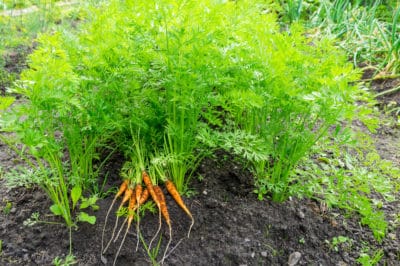Don’t Plant Until You’re Ready
There is a minimal amount of work involved in preparing to plant your carrots. Don’t put a single seed in the ground until you’ve properly prepared it! Doing the prep work improves your chances of a big, healthy, tasty harvest.
To prepare your garden for carrot seeds:
- Title When to Plant Carrots for a Great Harvest
- Till your garden deeply. At least eight to ten inches.
- Remove any rocks or other debris that would prevent your carrots from growing straight and pushing through the soil.
- Pick out any weeds or roots you find in your tilled earth.
- If your soil is thick or dense, work in some sand. Carrots need loose, well drained soil they can push through it easily.
- Nourish your soil with some bone meal or other phosphorous containing preparation; phosphorous is great for root vegetables.
- Avoid using manure or fertilizer containing nitrogen; these are detrimental to your carrot plants.
Don’t Plant Until You Know What You Want
There are several kinds of carrots you can grow. Color variations, mature size, and taste differences mark your choices. For instance, if you’d like to grow carrots that aren’t orange, there are red, purple, white, and even black varieties.
You can choose longer or shorter types, broader or narrower, and more. Do a little research and learn which carrot type will serve you best. You may want to plant several different carrot types and see which ones you like best.
Don’t Plant Without Water
In addition to a tilled garden and plenty of seed, you’ll need plenty of water for your carrot seeds to germinate. In fact, you’ll need to keep your carrot seeds moist until they’ve germinated fully. A soaker hose, a sprinkler, or just a regular watering schedule is necessary for the success of your carrot garden.
Don’t Plant Until You’ve Checked the Almanac
In short, plant your carrots two to three weeks before the last spring frost in your area, or ten to 12 weeks before your region’s first autumn frost. These are not exactly hard and fast rules, however; if you live in an area with a longer, cooler spring, you can plant later.
Now, It’s Time to Plant
When the last spring or first autumn frost is on the horizon, when your ground has been selected, turned, fertilized, and properly prepared, it’s time to get that seed in the ground. Plant your carrot seeds about half an inch to an inch apart, in rows. You’ll be thinning them twice in the near future, but for now, a small amount of space is fine.
After You’ve Planted
Once your carrots are in the ground, it’s time to water; your carrot seeds and sprouts need plenty of water, especially as the weather warms up. Your growing carrots will also need sufficient moisture to grow well.
As soon as your seeds are germinated and the seedlings are peeking through the soil, it’s time to mulch. A mulch over your emerging plants will help them retain moisture and protect their early roots from the hot sun.
Thinning and Baby Carrots
When your seedlings are three to four inches tall, you’ll need to thin them. Select the smallest starts, or the ones very close to one another, and thin until your plants are about a thumb width apart or slightly more.
About a month after the first thinning, thin again. This time, you’ll end up with plants about two inches apart. This is generally sufficient space for your carrots to grow in, although if you’ve chosen a stouter variety, you may want to allow another half an inch or so for them.
At your second thinning, you may pull some baby carrots; this is fine. Baby carrots are completely edible and these little gems are sweet, tasty, and delicious in many dishes.
Stagger Your Carrots for Longer Harvest
If you want a staggered harvest of carrots, plant seeds every two or three weeks until the middle of summer. Carrots are a plant that loves cooler weather and they taste better if they’ve experienced a frost or two, so planting a little late isn’t a big deal provided there’s time to germinate before the weather turns cold.
